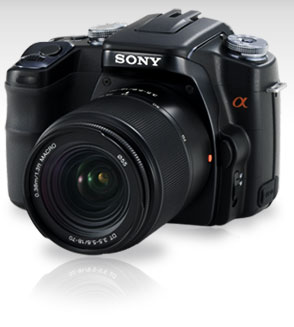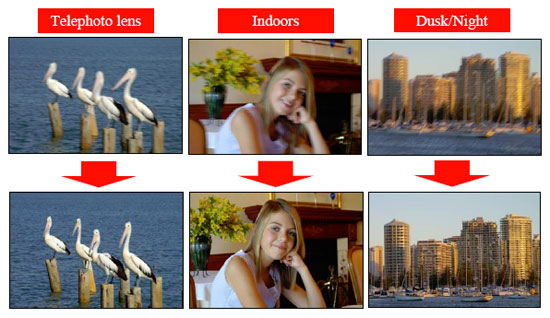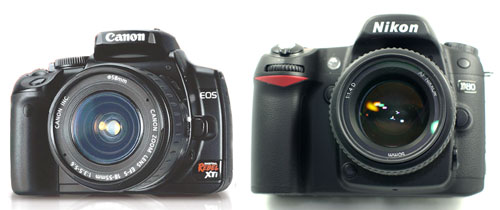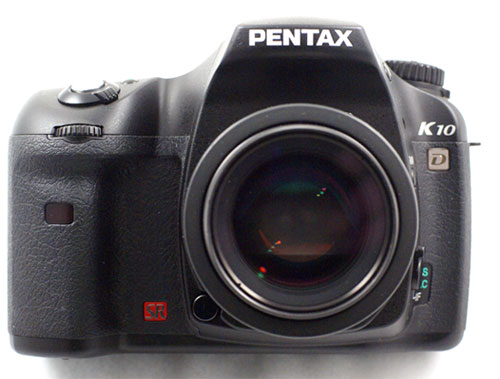10 Megapixel SLRs

The Sony A100 pioneered the 10 megapixel market when it was introduced this past summer. Sony acquired Minolta and based the new A100 on the entry level Minolta Maxxum 5D.

Sony continued the then-unique in-camera image stabilization pioneered by Minolta, which allowed any lens mounted on the camera to take sharper pictures at slower shutter speeds. Olympus had pioneered a popular feature that placed the sensor behind an antistatic protector, and that shook any stray dust off the sensor when the camera was turned on or shut down. Sony added a similar feature to their revision of the Maxxum digital SLR.
Sony inherited and continued the Minolta Maxxum autofocus lens mount, which meant almost any Minolta Maxxum lens ever made would work perfectly on the new Sony SLR camera. The A100 shocked the digital SLR market, since it brought the 10 megapixel resolution to market at a 6 megapixel price. This was also reflected in the selection of the Sony A100 as "Camera of the Year 2006" by the largest photo specialty magazine.

Canon and Nikon dominate the serious photography market, so it was no surprise that both followed in Sony's footsteps a couple of months later with their own 10 megapixel models. The Nikon D80 borrowed the processing engine, fast focusing module, and 10 megapixel sensor from their successful but expensive D200 model. All of the current 10 megapixel SLR cameras - except Canon - are based on the Sony 10 megapixel sensor. Nikon would point out, however, that the sensor interface and image processing "hardware" are their own design, and that the interface and processing account for much of how the sensor actually performs.
Canon basically increased the resolution of their CMOS sensor used in the 8 megapixel Rebel XT to 10 megapixels, and dubbed the revised camera the Canon Rebel XTi. They did incorporate the improved image processing guts of their semi-PRO 30D and finally added their own dust removal system - much like the one pioneered by Olympus. Canon also added dust removal capabilities to their bundled image-editing software.

The latest 10 megapixel SLR is the long-awaited Pentax K10D. Pentax took longest to get their 10 megapixel Sony sensor model to market, but the time certainly was not wasted. In many ways the Pentax is the most professional and full-featured of the 10 megapixel choices, since it incorporates special sealing for dust and moisture protection, similar to the sealing of the top professional SLR models. Pentax also refined the "in-camera" anti-shake pioneered by Minolta/Sony by adding permanent magnets in both horizontal and vertical planes. This allows rotation in the diagonal as well as horizontal/vertical planes and is claimed to extend low-light shooting up to four full f-stops.
Pentax also brought over their innovative hyper-program feature from top Pentax cameras of the past. This allows users to keep the camera on program and adjust either aperture or shutter speed to what they want in a shot. The program compensates by adjusting the other program variables automatically. Pentax added "ISO Priority" to the typical SLR offerings of full program (green zone), program, aperture-priority, shutter-priority, and full manual. This seemed a natural extension of one of the Digital SLR's best features - built-in film (Sensor) with very wide sensitivity (ISO). To top it off Pentax made sure the new K10D, and lower-priced K100D and K110D, would be fully compatible with any K-mount lens ever produced, including excellent "focus-assist" features for non AF lenses and the ability to manually dial in info from very old lenses that can still benefit from Pentax lens stabilization.
These four cameras are loaded with features and represent the current crop of 10 megapixel offerings. Samsung has also announced they will be marketing a 10 megapixel model just after the holidays which is to be called the Samsung GX-10. The new Samsung model is basically a relabeled Pentax with the same feature set.

The Sony A100 pioneered the 10 megapixel market when it was introduced this past summer. Sony acquired Minolta and based the new A100 on the entry level Minolta Maxxum 5D.

Sony continued the then-unique in-camera image stabilization pioneered by Minolta, which allowed any lens mounted on the camera to take sharper pictures at slower shutter speeds. Olympus had pioneered a popular feature that placed the sensor behind an antistatic protector, and that shook any stray dust off the sensor when the camera was turned on or shut down. Sony added a similar feature to their revision of the Maxxum digital SLR.
Sony inherited and continued the Minolta Maxxum autofocus lens mount, which meant almost any Minolta Maxxum lens ever made would work perfectly on the new Sony SLR camera. The A100 shocked the digital SLR market, since it brought the 10 megapixel resolution to market at a 6 megapixel price. This was also reflected in the selection of the Sony A100 as "Camera of the Year 2006" by the largest photo specialty magazine.

Canon and Nikon dominate the serious photography market, so it was no surprise that both followed in Sony's footsteps a couple of months later with their own 10 megapixel models. The Nikon D80 borrowed the processing engine, fast focusing module, and 10 megapixel sensor from their successful but expensive D200 model. All of the current 10 megapixel SLR cameras - except Canon - are based on the Sony 10 megapixel sensor. Nikon would point out, however, that the sensor interface and image processing "hardware" are their own design, and that the interface and processing account for much of how the sensor actually performs.
Canon basically increased the resolution of their CMOS sensor used in the 8 megapixel Rebel XT to 10 megapixels, and dubbed the revised camera the Canon Rebel XTi. They did incorporate the improved image processing guts of their semi-PRO 30D and finally added their own dust removal system - much like the one pioneered by Olympus. Canon also added dust removal capabilities to their bundled image-editing software.

The latest 10 megapixel SLR is the long-awaited Pentax K10D. Pentax took longest to get their 10 megapixel Sony sensor model to market, but the time certainly was not wasted. In many ways the Pentax is the most professional and full-featured of the 10 megapixel choices, since it incorporates special sealing for dust and moisture protection, similar to the sealing of the top professional SLR models. Pentax also refined the "in-camera" anti-shake pioneered by Minolta/Sony by adding permanent magnets in both horizontal and vertical planes. This allows rotation in the diagonal as well as horizontal/vertical planes and is claimed to extend low-light shooting up to four full f-stops.
Pentax also brought over their innovative hyper-program feature from top Pentax cameras of the past. This allows users to keep the camera on program and adjust either aperture or shutter speed to what they want in a shot. The program compensates by adjusting the other program variables automatically. Pentax added "ISO Priority" to the typical SLR offerings of full program (green zone), program, aperture-priority, shutter-priority, and full manual. This seemed a natural extension of one of the Digital SLR's best features - built-in film (Sensor) with very wide sensitivity (ISO). To top it off Pentax made sure the new K10D, and lower-priced K100D and K110D, would be fully compatible with any K-mount lens ever produced, including excellent "focus-assist" features for non AF lenses and the ability to manually dial in info from very old lenses that can still benefit from Pentax lens stabilization.
These four cameras are loaded with features and represent the current crop of 10 megapixel offerings. Samsung has also announced they will be marketing a 10 megapixel model just after the holidays which is to be called the Samsung GX-10. The new Samsung model is basically a relabeled Pentax with the same feature set.










89 Comments
View All Comments
Justin Case - Wednesday, December 27, 2006 - link
I've used a K10D for about 20 minutes - enough to see that the image quality seems _worse_ than the K100D (which was actually quite promising). With a 10-MP sensor, it can't quite match the detail of an 8-MP Canon. But, above all, it has a lot more CA. Where a Canon or a Nikon (or even a Sony) will get you crisp neutral edges, the K10D gives you red / cyan fringing. Maybe it's CA from the lens, maybe it's just poor processing of the Bayer-pattern sensor. Either way, it's there and it hurts the image quality.Add to that the lens selection (which is what SLRs are all about - keep the glass, upgrade the camera), and the K10D only really makes sense to someone who already has a lot of money invested in K-mount lenses.
If you want a longer "article" I'll be happy to write one, but don't expect me to do your job for free.
Anyway, there are already plenty of articles about these cameras. It just seems that almost everyone reached a conclusion different from yours (the K10D is a good camera, just not the best, and Pentax lenses definitely aren't the best). I guess those guys at DPReview, Steve's Digicams, etc, just don't know anything about photography...
feraltoad - Thursday, December 28, 2006 - link
I think you, Justin Case, are fairly knowledgeable and have a lot of experience with photography. I also think that you consider Anandtech to have overstepped its bounds by venturing into reviewing photography equipment. Therefore, although I may be wrong, I certainly have to take everything you say with a very large grain of salt since you seem to have ulterior motives that run along the vein of checking this sites "impudence". Also, you seem like a real asshat. My sincere apologies if I am mistaken, but the value of any of your comments are eroded and negated by the contempt.Justin Case - Thursday, December 28, 2006 - link
I have nothing against Anandtech (or any other site) reviewing cameras or writing about photography. In fact, I've mentioned above (or possibly below) that Dan's Data (for example) has several good articles about photography. And there are several brilliant articles about photography on sites like Slashdot, Kuro5hin, etc., not to mention photography websites, of course.My problem is when someone without any knowledge of a given subject (any subject) decides to hack together an "article" about it, based on very little experience, incomplete information, and a bunch of specifications they don't really understand.
It's like evaluating a sports car performance by looking at the engine specifications. They're not completely irrelevant, but they don't tell the full story (or even the first paragraph) of what it's like to actually drive the car. Anyone can compare manufacturer's PDFs and repost images from the manufacturers' advert^H^H I mean, press kits.
And people who do that are only spreading misinformation, for the sake of their own egos or (more likely) a few thousand ad impressions and sponsored link clicks. And that pisses me off, because, although I can spot the bullshit on subjects that I know (like photography, or computers), I might be (and have been in the past) misled by this kind of approach to "journalism" in other areas.
This is a review of four cameras where the author doesn't even compare or show photos taken with those cameras. Enough said.
Anandtech has been going downhill for some time now. If it wasn't for Johan (and some of Anand's own articles), I think it would make even THG seem respectable.
Frumious1 - Thursday, December 28, 2006 - link
Why don't you just go the fuck elsewhere then? Every comment you post seems to bitch about the quality of Anandtech in some way - even the offhand compliment to Johan was used as a way to bash the other writers. I guess the video card information, buyers guides, motherboard reviews, etc. just suck ass, don't they? Sort of like your posts.I for one understand what is meant by BUYER'S GUIDE! It's not a goddamn review of every item mentioned. If they were, this SLR BG would be about 20000 words instead of 5000, and the various computer buyer's guides would probably clock in at something like 50000 words. Obviously, this GUIDE didn't cover every detail of every camera, and most of us aren't - as the above poster so eloquently put it - asshats that like to nitpick.
I read this article and came away with the impression that all of the expensive cameras are good in their own ways, and Sony and Pentax are able to compete with the Canon and Nikon. Does that mean they are universally better? OF COURSE NOT! No one with half a brain would get that from the text, which is clearly intended to be a brief overview rather than covering every facet. Now, having read this BG, people might be more inclined to do a bit more research on the Sony and Pentax models rather than just buying a Canon or Nikon like everyone seems to recommend. Or they might end up sticking with Canon/Nikon for various reasons. There is definitely a market for higher quality SLR cameras without the intention of investing in dozens of lenses, though, which you STILL fail to grasp.
What I've gathered is that you think Canon and Nikon are the shizznit, and you tried a Pentax for 20 minutes and decided it sucked. Obviously, you know way more about photography than I do, but at the same time I wouldn't presume to judge any PC product after only 20 minutes, even though I've been using PCs for almost 30 years now and have a pretty extensive background in the industry.
What's really humorous is that all of your other beloved camera-centric sites that have looked at the K10D seem to rate it as essentially the equal of the Canon and Nikon offerings, and quite a few have been damn impressed by the Sony as well. If you have $10K of lenses for Canon or Nikon, of course you're not going to bail on that just to switch to a new body that might be better in a few areas. For the many people that are now looking at potentially affordable $500-$700 SLR cameras, though - people that very likely don't own a single camera lens yet - it doesn't matter nearly as much.
I'm NEVER EVER going to spend $1000+ on a camera lens, and probably not even more than $150. A decent SLR can still serve a purpose, however, as the best quality point-and-shoots rarely if ever offer all of the features of a moderate SLR. Only the larger SLR-like point-and-shoot cameras can handle lower light situations even remotely effectively, and those typically cost as much or more than entry level SLR.
Again, though, maybe I'm mistaken? What's the best point and shoot out there for the various markets? Specifically, what $500 PaS is going to be better than the $500 SLRs mentioned, or what $750 model will beat the Sony? Don't tell me something like a Canon Powershot either, as I have one and while it's great for stuffing in my pocket there are MANY situations where the images I've captured look very poor (not to mention much slower focusing speed, inability to take fast-motion shots, and a number of other issues).
Anyway, I'd really be quite pleased if you left and spent more time over at Tom's bitching and moaning. They're used to it there and rarely bother responding to criticisms. They are also clearly "bought out" when you read many of their reviews. Just like HardOCP and Kyle's lovefest for anything AMD (or whoever else is willing to buy him a new truck). Your primary ASSumption here has been that Wes knows nothing about photography, and quite clearly that is not the case. He said some stuff you disagree with, and so immediately you label him "clueless" - and yet you haven't actually done ANY testing with several of the products he talks about, so you're basically just shooting from the hip and going with what you've read elsewhere. Talk about doing comparisons based off of "spec sheets" (reviews)....
When you've actually tried a Pentex K10D for a couple months with a variety of lenses, come back and tell us how it really compares and then we might listen. Yeah, that's expensive, and that's precisely why none of us will do it. Until you can actually do so, though (borrow a friend's camera and leave your biases behind), you're basically just telling us what everyone already knows: if you have a major investment in Nikon or Canon equipment and you're happy with it, there's no way in hell you would ever switch to a different brand.
Wesley Fink - Wednesday, December 27, 2006 - link
Actually dpreview total scores for the 4 cameras were 53 for the Nikon D80, 52 for the Pentax K10D, 50.5 for the Canon XTi, and 50 for the Sony A100. Since the Sony is now the cheapest 10 MP camera it's value score would likely go up in an updated review, making the Canon the worst of the lot. Dpreview also gave all 4 cameras their "Highly Recommended" rating.I also found the Pentax K10D and Nikon D80 the closest of the group, but it is my opionion the anti-shake, built-in sensor cleaning, better build quality, and unique creative features tilted the recommendation to the Pentax. It should be mentioned that Pentax includes their excellent RAW editing software with the K10D, while Nikon makes you buy their best RAW software as an add-on to the D80. If you are going to quote other sites as evidence to support your own beliefs you should get your facts right.
BTW, not a single review I read found an issue with red-cyan fringing. I also looked at all the images I shot and did not see any unusual "red-cyan" edge fringing as you describe. Perhaps you looked at a defective sample. Did you find the same issues with RAW images?
Wesley Fink - Tuesday, December 26, 2006 - link
It seems you always get accused of being a fanboi if you recommend anything other than the safe - in this case Canon or Nikon. I would suggest you compare a Nikon D40 and Pentax K100D side by side as we did - you might actually be surprised. As for the K110D there is no other camera that sells for $450 with lens, let alone one as full -faeatured as the K110D. The same goes for the 10 megapixel models. As I said in the review the safe choice is Canon or Nikon, and Canon will sell a ton of cameras even if it is the worst of the 10 megapixel models.Actually I have owned Canon and Nikon for years, and the D80 has been a personal favorite since it came out. It is still the best in autofocusing speed compared to anything, but I was blown away by the quality and features of the K10D. Another AT reviewer, who owns Minolta/Sony recently got a chance to examine and use the K10D on a trip to China and was trying to figure out if it made sense to sell his existing lenses and camera to buy the K10D. The concern, of course, is Pentax is no Canon in size and the best value from smaller players does not always win in the marketplace.
Justin Case - Wednesday, December 27, 2006 - link
No. If you recommend a Canon, the Nikon fanboys will label you a Canon fanboy. If you recommend a Nikon, then the Canon fanboys will label you a Nikon fanboy.But when you recommend a Pentax SLR, you're labelling youself "clueless".
gibhunter - Tuesday, December 26, 2006 - link
I like that you guys tested auto focus speed, but your test is incomplete. All dslr cameras perform well in good light. What sets them apart is their performance as light levels drop to where you need to use fast lenses such as the 50mm f/1.4 and ISO 1600 to achieve shutter speeds fast enough not to have blurry shots due to camera shake. Yes, the Sony and Pentax systems will greatly help with the camera shake, but both have some serious shortcomings.Sony has very high noise levels. Their noise at ISO 800 is greater than Pentax, Canon or Nikon at ISO 1600. Sony's ISO 1600 is barely usable and limited mainly to small prints.
Pentax controls noise very well, but its autofocus performance in low light indoor photography from my experience with the K100D is very slow. It often takes well over a second to achieve focus lock. In comparison it takes the Nikon, Sony and Canon less than 3/4 of a second. It's a difference that can result in some missed photos.
Your tests address the noise issue, but they do not touch on low light focusing speed and it would be of great interest to see if Pentax improved on the K100D with their K10D.
takumsawsherman - Tuesday, December 26, 2006 - link
While my Sony experiences have not been great, for many years I have enjoyed shooting with Minolta Maxxum cameras, from the 7000 to the Alpha 707si (if not for being stolen I would still be using my 7000s). Minolta didn't get too much love in the pro market, but they truly had some wonderful equipment, especially the older lenses. In the last few years manufacturing was not as high quality, but I have used Nikon, Canon and Pentax, and still prefer the Maxxum (though the K1000 was a great cheap SLR that could take a beating).So it is nice to hear that Sony has apparently made a decent camera with Maxxum lens compatibility. I don't shoot digital, for many reasons, but the anti-shake (I'm horrible in low-light) and reasonable price tempts me. The adjustable diopter might help me with my focus, too, as I use my focusing ring to make up for not wearing corrective eye-wear :).
yyrkoon - Tuesday, December 26, 2006 - link
I have a Sony dsc-p200 P&S 7MP camera, and I have to say, for what it is, its great, however, don't expect to take pictures on the moon, and get surface detail . . . I know a professional photographer that uses this same camera for quick shots, and he loves it(this is how I came about getting mine, got to try it before i bought it ;) ).Another friend of mine, has a Cannon 20D, it also is an excellent camera, but its getting dated, and the XTi IMO comes from great lines, but just isn't up to the rest in quality.
Personally, I've been interested in the Nikon D80 for some time, but perhaps by the time I get ready to spend, the Pentax will win me over . . .